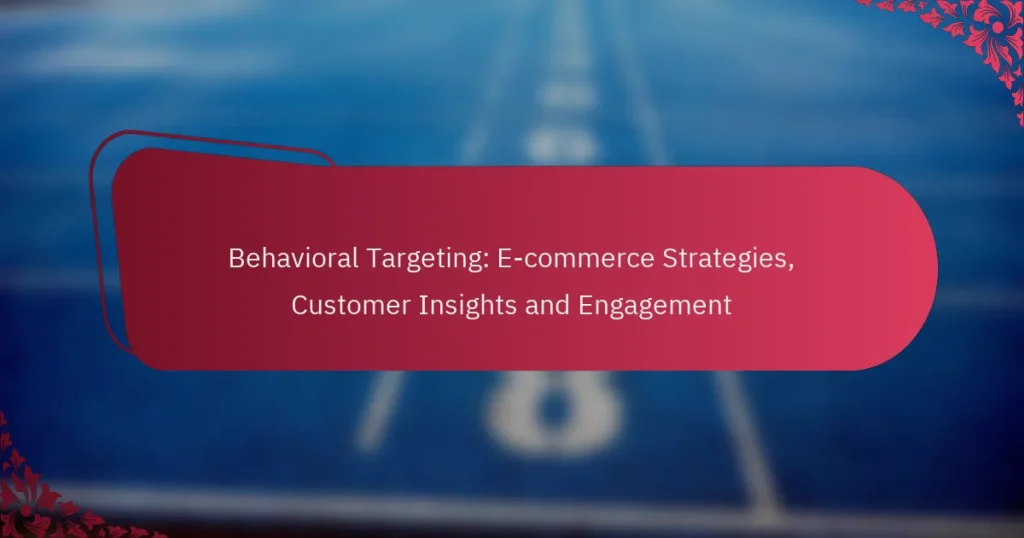Behavioral targeting plays a crucial role in enhancing e-commerce in Estonia by customizing marketing strategies to align with individual customer behaviors and preferences. By leveraging customer data, businesses can create more relevant advertisements and product recommendations, leading to increased sales and stronger customer loyalty.

How does behavioral targeting enhance e-commerce in Estonia?
Behavioral targeting significantly boosts e-commerce in Estonia by tailoring marketing efforts based on individual customer behaviors and preferences. This approach leads to more relevant advertisements and product recommendations, ultimately driving sales and customer loyalty.
Increased conversion rates
Behavioral targeting can lead to increased conversion rates by presenting customers with products that align with their interests and past behaviors. For instance, if a customer frequently browses outdoor gear, targeted ads for hiking equipment can prompt quicker purchase decisions.
Estonian e-commerce platforms can utilize analytics to track user interactions and optimize their offerings accordingly. This data-driven approach often results in conversion rate improvements of 10-30% compared to generic marketing strategies.
Improved customer engagement
Improved customer engagement is a direct benefit of behavioral targeting, as it fosters a more personalized shopping experience. When customers receive tailored content, they are more likely to interact with the brand, whether through social media, newsletters, or product reviews.
In Estonia, brands can enhance engagement by using targeted email campaigns that reflect user preferences. For example, sending personalized recommendations based on previous purchases can keep customers interested and encourage repeat visits.
Personalized shopping experiences
Personalized shopping experiences are crucial in retaining customers and enhancing their overall satisfaction. Behavioral targeting allows e-commerce sites to curate product selections that resonate with individual shoppers, making the shopping process more enjoyable.
Estonian retailers can implement features like personalized landing pages or dynamic product recommendations based on browsing history. This not only improves user experience but can also lead to higher average order values, as customers are more likely to explore suggested items that match their interests.

What are effective behavioral targeting strategies for Estonian e-commerce?
Effective behavioral targeting strategies for Estonian e-commerce involve utilizing customer data to personalize marketing efforts. By understanding user behavior, businesses can enhance customer engagement and increase conversion rates.
Dynamic retargeting ads
Dynamic retargeting ads display personalized advertisements to users based on their previous interactions with a website. For instance, if a customer viewed specific products but did not purchase, these items can be featured in ads across various platforms. This approach can significantly boost the likelihood of conversion by reminding users of their interests.
To implement dynamic retargeting, businesses should ensure they have a robust tracking system in place, such as using cookies or pixel tracking. It’s essential to create visually appealing ads that resonate with the target audience while avoiding excessive frequency that may lead to ad fatigue.
Segmentation based on browsing behavior
Segmentation based on browsing behavior involves categorizing customers into distinct groups according to their online activities. This can include factors such as pages visited, time spent on site, and products viewed. By segmenting users, e-commerce platforms can tailor their marketing messages to meet the specific needs of each group.
For effective segmentation, businesses should utilize analytics tools to gather data and identify patterns. This allows for targeted email campaigns or personalized website experiences that cater to different customer segments, enhancing overall engagement and satisfaction.
Predictive analytics for customer preferences
Predictive analytics leverages historical data to forecast future customer preferences and behaviors. By analyzing past purchase patterns and browsing history, e-commerce businesses can anticipate what products or services a customer may be interested in. This proactive approach can lead to more effective marketing strategies and improved customer retention.
To utilize predictive analytics, companies should invest in data analysis tools and machine learning algorithms. Regularly updating the data and refining the models will ensure that predictions remain accurate and relevant, ultimately driving sales and enhancing the customer experience.

How can e-commerce businesses leverage customer insights?
E-commerce businesses can effectively leverage customer insights by understanding their preferences and behaviors. This knowledge allows companies to tailor their marketing strategies, enhance customer engagement, and ultimately drive sales.
Utilizing customer feedback
Collecting and analyzing customer feedback is crucial for e-commerce businesses. This can be done through surveys, product reviews, and social media interactions, providing valuable insights into customer satisfaction and areas for improvement.
To effectively utilize feedback, businesses should categorize responses to identify common themes. Regularly updating customers on how their feedback has influenced changes can also foster loyalty and encourage further engagement.
Analyzing purchase history
Analyzing purchase history helps e-commerce businesses understand buying patterns and preferences. By examining what products customers frequently buy together or their seasonal purchasing habits, companies can create targeted marketing campaigns.
For instance, businesses can use this data to recommend complementary products or offer personalized discounts. Segmenting customers based on their purchase behavior can also enhance the effectiveness of promotional strategies.
Implementing A/B testing
A/B testing allows e-commerce businesses to compare two versions of a webpage or marketing material to determine which performs better. This method provides direct insights into customer preferences and can significantly improve conversion rates.
When conducting A/B tests, it’s essential to focus on one variable at a time, such as call-to-action buttons or email subject lines. Analyzing the results can guide future marketing decisions and optimize the overall customer experience.

What tools facilitate behavioral targeting in Estonia?
In Estonia, various tools enhance behavioral targeting by analyzing customer data and optimizing marketing strategies. These tools help e-commerce businesses understand user behavior, allowing for more effective engagement and conversion tactics.
Google Ads for retargeting
Google Ads enables businesses to retarget users who have previously interacted with their website. By displaying tailored ads to these users across the Google Display Network, businesses can remind potential customers of products they viewed, increasing the likelihood of conversion.
To effectively use Google Ads for retargeting, set up remarketing lists based on user behavior, such as page visits or cart abandonment. Keep ad creatives fresh and relevant to maintain user interest and avoid ad fatigue.
Facebook Ads for audience segmentation
Facebook Ads allows for precise audience segmentation based on user demographics, interests, and behaviors. This capability enables e-commerce businesses to create highly targeted campaigns that resonate with specific customer segments.
Utilize Facebook’s Custom Audiences feature to reach users who have engaged with your brand before. Experiment with Lookalike Audiences to find new potential customers similar to your existing ones, maximizing your ad spend efficiency.
Hotjar for user behavior analysis
Hotjar provides insights into user behavior through heatmaps, session recordings, and surveys. This tool helps e-commerce businesses understand how visitors interact with their website, identifying areas for improvement.
Implement Hotjar to analyze user engagement patterns and optimize website design accordingly. Regularly review feedback from surveys to gather direct insights from customers, which can inform product offerings and marketing strategies.

What are the challenges of implementing behavioral targeting?
Implementing behavioral targeting presents several challenges, including data privacy concerns, technical integration issues, and maintaining customer trust. Each of these factors can significantly impact the effectiveness and acceptance of targeted marketing strategies.
Data privacy concerns
Data privacy is a critical challenge in behavioral targeting, as consumers are increasingly aware of how their data is collected and used. Regulations like the General Data Protection Regulation (GDPR) in Europe impose strict guidelines on data handling, requiring businesses to ensure transparency and obtain consent.
To navigate these concerns, e-commerce businesses should prioritize clear communication about data usage and provide easy options for customers to manage their preferences. Implementing robust data protection measures can also help alleviate fears and build confidence in the targeting process.
Technical integration issues
Technical integration challenges arise when trying to unify various data sources and marketing platforms for effective behavioral targeting. Businesses often struggle with disparate systems that do not communicate well, leading to incomplete or inaccurate customer profiles.
To address these issues, companies should invest in comprehensive customer relationship management (CRM) systems and data analytics tools that facilitate seamless integration. Regular audits of data flows and system compatibility can also help identify and resolve integration bottlenecks.
Maintaining customer trust
Maintaining customer trust is essential for successful behavioral targeting, as intrusive or poorly executed campaigns can lead to negative perceptions. Customers may feel uncomfortable if they perceive that their online behavior is being excessively monitored or exploited.
To foster trust, businesses should focus on delivering personalized experiences that genuinely add value. Transparency about targeting practices, along with providing customers with control over their data, can enhance trust and encourage positive engagement with marketing efforts.


